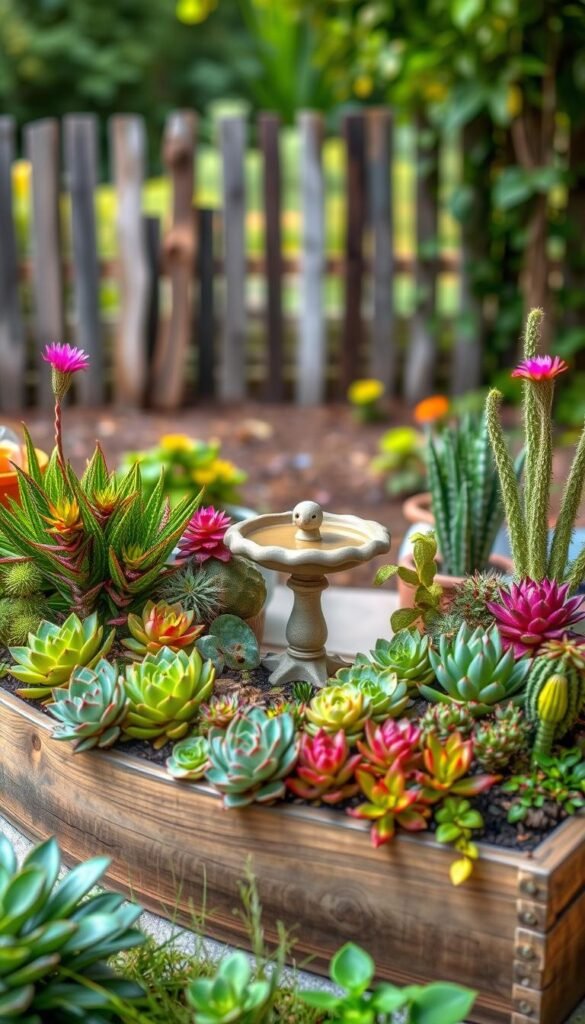Ready to grow fresh herbs or create a stunning green display? Your space could become a thriving oasis with one key decision: where to place your plants. This choice impacts everything from growth rates to maintenance needs, making it the foundation of your gardening success.
Sunlight lovers like succulents thrive near windows, while shade-tolerant varieties might prefer cozy corners. Outdoor spaces offer natural light cycles, but indoor setups let you control temperatures year-round. Think about your daily routine—how much time can you dedicate to watering or adjusting conditions?
Seasonal changes matter too. A windowsill herb garden brings summer flavors indoors during winter, while patio arrangements let you experiment with seasonal blooms. Your lifestyle plays a bigger role than you might think—busy schedules often work better with low-maintenance options.
We’ll explore lighting needs, space-saving tricks, and microclimate tips to help your greenery flourish. Whether you’re nurturing edible plants or decorative specimens, the right location turns challenges into growth opportunities. Let’s find your perfect match.
Setting the Stage for Your Gardening Adventure
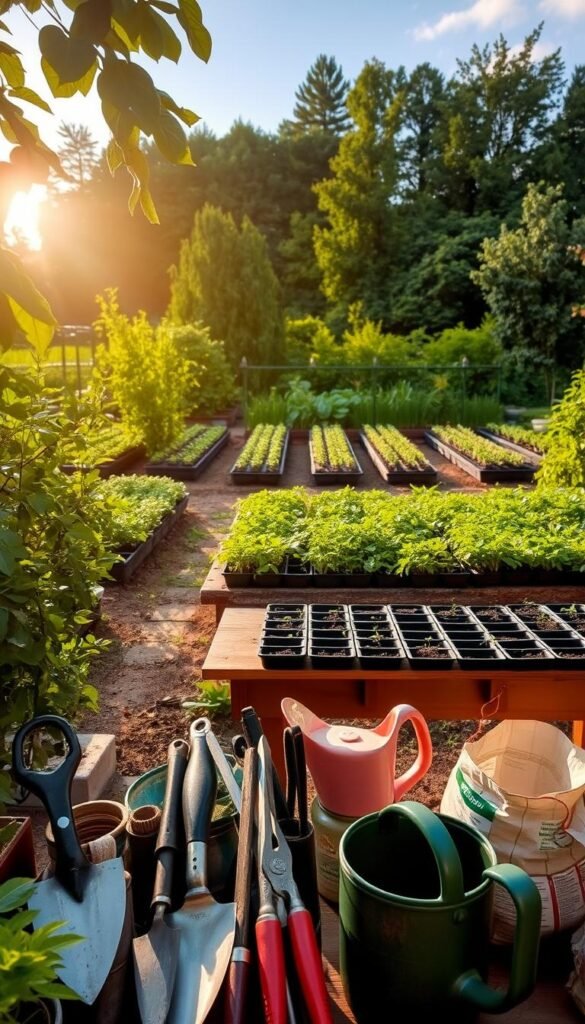
Imagine transforming any corner of your home into a vibrant living canvas. This journey begins with thoughtful planning—not just picking pretty containers or trendy greenery. Your success hinges on matching your green companions to your daily rhythm and environment.
- How much natural light does your space receive daily?
- What’s your weekly time budget for plant care?
- Are you growing for beauty, fresh herbs, or stress relief?
Seasoned gardeners know that rushing leads to wilted dreams. A windowsill basil plant needs different attention than a succulent arrangement. Track sunlight patterns for a week—morning rays differ from harsh afternoon beams.
Create a simple maintenance schedule. Even low-effort plants thrive with consistency. Use phone reminders for watering days or invest in self-watering pots if travel fills your calendar.
Your garden should adapt to you, not the other way around. Start small with 2-3 compatible species. As confidence grows, expand your leafy family. This approach builds skills while minimizing overwhelm.
Remember: Every thriving indoor jungle or patio display began with one thoughtful choice. Your perfect green haven awaits—craft it at your pace.
Understanding the Comparison: Indoor and Outdoor Dish Gardens
Creating a miniature ecosystem in your living space starts with understanding container gardening’s creative potential. Dish gardens blend textures, colors, and growth habits to form eye-catching displays. These arrangements thrive when their environment matches their needs—a balance between artistry and practicality.
Defining the Dish Garden Concept
Think of these setups as living collages. You combine species with similar light and water needs in shallow containers, creating cohesive themes. Tropical ferns might share space with mosses indoors, while drought-tolerant sedums cluster outdoors. The container’s depth matters—it limits root growth but encourages visual harmony.
Your plant choice determines the garden’s personality. Mix trailing ivy with upright snake plants for contrast, or pair flowering varieties with textured foliage. Every selection impacts maintenance—some groupings need weekly attention, others thrive on neglect.
The Value of Comparing Growing Environments
Indoor setups let you control temperatures and humidity, perfect for delicate species. However, you’ll work with limited light angles and seasonal consistency. Outdoor spaces offer natural sunlight cycles but demand weatherproof containers and hardier plants.
Consider these factors:
- Airflow differences affect pest resistance
- Natural rainfall vs. manual watering routines
- Space constraints in apartments versus patio flexibility
Your gardening goals shape the best location. Want low-effort beauty? Try succulents near a sunny window. Crave seasonal experimentation? Outdoor herb clusters offer changing harvests. Matching conditions to plant needs turns challenges into thriving displays.
Key Factors to Consider for Your Garden’s Location
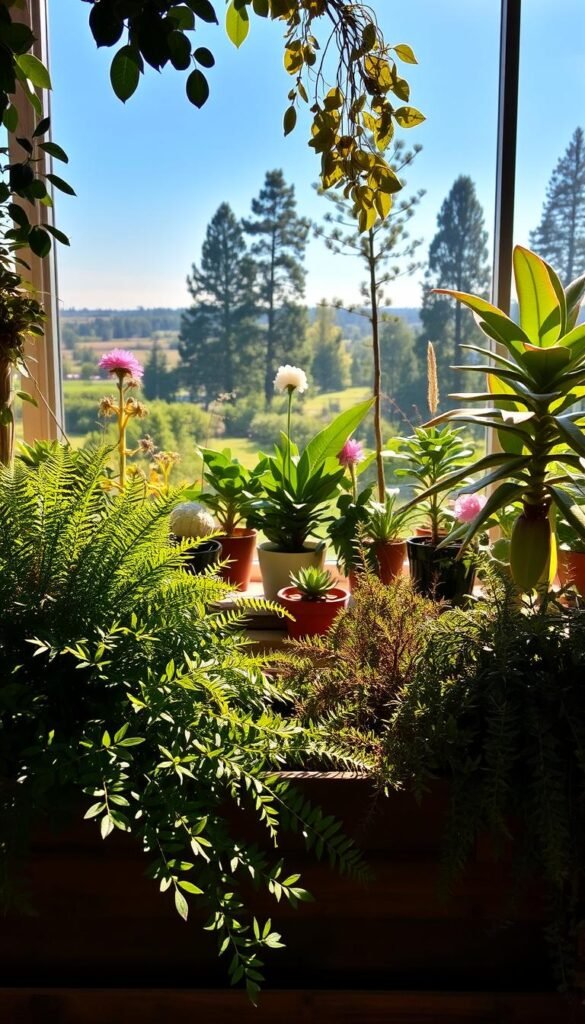
Location isn’t just about where you place your greenery—it’s about creating harmony between their needs and your environment. Three elements make or break your success: available space, light access, and protection from surrounding conditions.
Space, Sunlight, and Environmental Exposure
Fruiting varieties like peppers demand 6-8 hours of direct sunlight daily. South-facing spots often deliver this, while north-facing areas suit shade-loving herbs. Measure light patterns across different times—morning rays differ from afternoon intensity.
Your space needs more than square footage. Can you reach every pot easily? Is there a water source nearby? Wind patterns matter outdoors—a breezy balcony might dry soil faster. Indoors, watch for vents blowing hot or cold air directly on leaves.
Unique Challenges in Each Setting
Outdoor spots battle weather swings and pests. Heavy rains drown roots, while heatwaves scorch leaves. Indoor setups fight stale air and limited light angles. You’ll need grow lights for dark corners or rotate pots weekly for even growth.
Each location demands tailored care. Outdoor plants might need staking against wind, while indoor ones require humidity trays. Track how conditions change through seasons—that sunny winter windowsill could become a summer oven.
Choose plants that match your spot’s personality. High-light succulents thrive in south windows, while ferns prefer shaded bathrooms. Test one species first before expanding—your perfect green balance awaits.
Evaluating Your Available Space and Lighting Needs
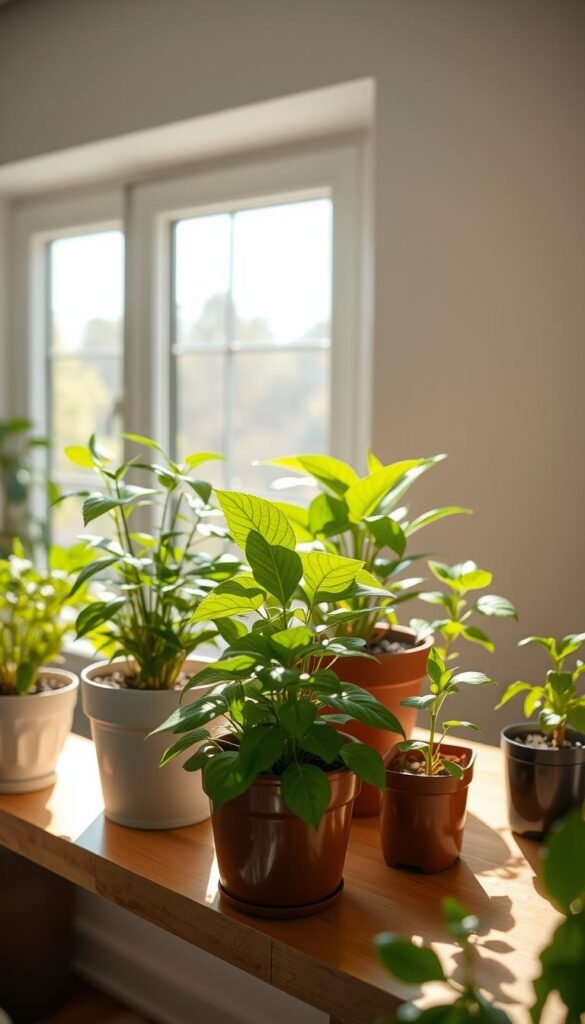
Light becomes your garden’s best friend or toughest critic. Start by mapping how sunshine dances through your rooms or patio throughout the day. South- and west-facing windows often deliver golden-hour glows, but winter’s shorter days might leave even these spots wanting.
Assessing Natural Light vs. Artificial Light Options
Track sunlight patterns for a week using your phone’s camera. Notice how shadows shift—what’s bright at noon might dim by afternoon. For plants craving intense rays (like tomatoes or citrus), consider full-spectrum bulbs when natural light fades. These mimic the sun’s spectrum without baking your home.
Grow lights work wonders in darker corners. Position them 6-12 inches above foliage, using timers for 12-16 hour cycles. Energy-efficient LED options keep costs low while supporting leafy growth. Rotate pots weekly to prevent lopsided stretching toward light sources.
Maximizing Limited Spaces in Your Home or Outdoors
Vertical gardens turn blank walls into lush displays. Try hanging planters for trailing varieties or stack shelves for herb collections. Outdoors, tiered plant stands let you grow upward—perfect for patios or balconies. Compact indoor setups thrive with magnetic pots on fridge doors or windowsill trays.
Measure your space twice before planting. Leave room for mature sizes—overcrowding invites pests. Ensure easy access for watering and pruning. A rolling cart lets you chase sunlight indoors, while outdoor benches double as storage for tools under planters.
Outdoor Dish Garden: Embracing Natural Conditions
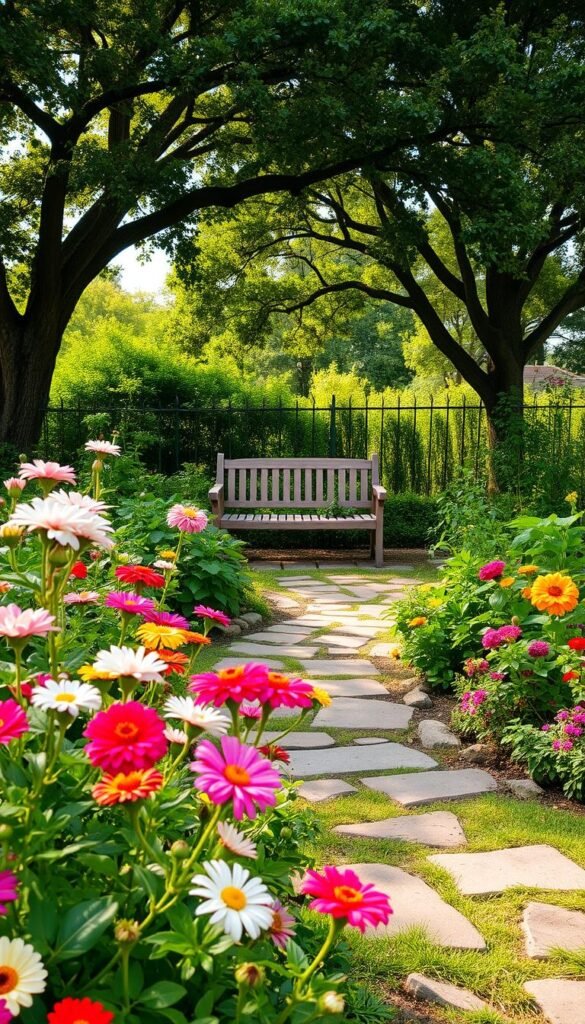
Nature becomes your strongest ally when cultivating greenery under open skies. Let the elements work with you rather than against you, creating living art that changes daily.
Benefits of Using the Great Outdoors
Your plant palette explodes with options outside. Combine edible herbs with flowering shrubs or mix textures using trailing vines and spiky succulents. These combinations attract:
- Bees drawn to purple coneflowers
- Butterflies landing on milkweed
- Hummingbirds sipping from trumpet vines
Rainwater naturally nourishes roots, while breezes strengthen stems. You’ll notice healthier growth patterns compared to indoor setups—no need for rotating pots or artificial airflow.
Weather and Seasonal Influences
Each season brings new opportunities. Spring rains encourage rapid growth, while autumn chill intensifies foliage colors. Prepare for challenges:
Summer heat might require afternoon shade cloths. Winter frosts demand protective covers for tender varieties. Track local weather patterns using apps to anticipate sudden changes.
Select plants matching your region’s climate. Drought-tolerant sedums thrive in arid zones, while ferns flourish in humid areas. This strategic pairing reduces maintenance while maximizing visual impact through seasonal shifts.
Indoor Dish Garden: Creating a Controlled Environment
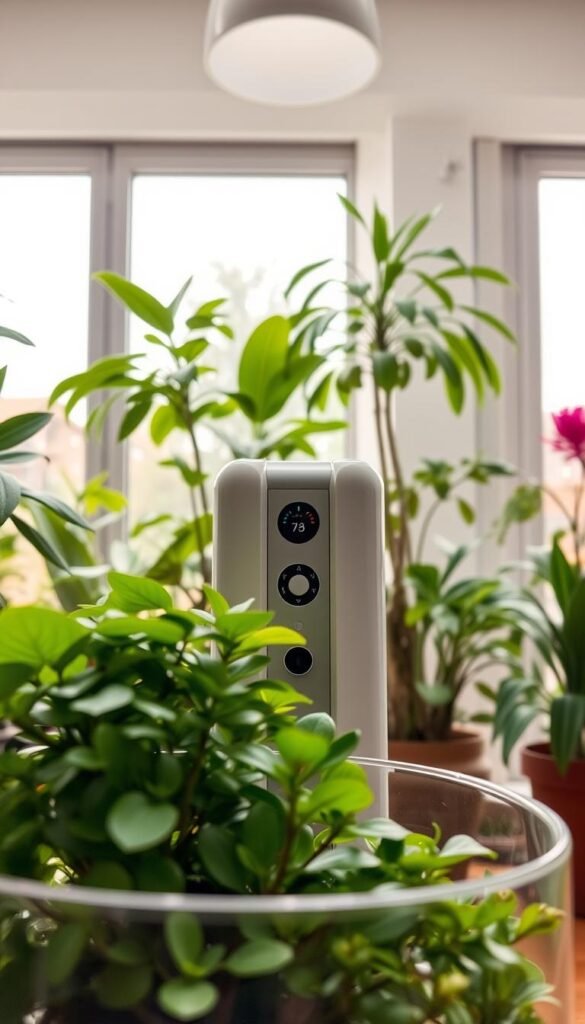
Transform your living space into a thriving ecosystem where every leaf tells a story. Indoor arrangements let you play Mother Nature—dialing in precise conditions for lush growth year-round. Consistency becomes your superpower when nurturing delicate tropicals or fussy orchids.
Climate Crafting Made Simple
Keep ferns happy with 60% humidity using a $20 mister. Tropical varieties thrive at 75°F—the sweet spot between comfort and growth. Use this quick-reference table to match plants with their ideal conditions:
| Plant Type | Temp Range | Humidity | Light Needs |
|---|---|---|---|
| Snake Plant | 60-85°F | 40% | Low |
| Peace Lily | 65-80°F | 50-60% | Medium |
| Orchid | 70-80°F | 60-70% | Bright |
Smart Tech for Greener Thumbs
Modern gadgets take the guesswork out of plant parenting. Programmable grow lights mimic sunrise/sunset cycles. Soil sensors text you when hydration levels drop. One study found:
“Plants grown with smart systems showed 23% faster growth than traditionally cared-for specimens”
Pair these tools with air-purifying plants like spider varieties to create healthier living spaces. NASA research confirms certain species remove 87% of airborne toxins within 24 hours. Your green oasis becomes a wellness hub—beauty and function in perfect balance.
Outdoor vs. Indoor Dish Garden: Choosing the Right Location for Your Plants
The journey to a thriving plant collection starts with matching their world to yours. Your decision shapes growth patterns, maintenance routines, and even your enjoyment of the process. Let’s break down what truly matters when picking your greenery’s home.
Start by asking practical questions. How often can you check soil moisture? Does your schedule allow for seasonal adjustments? Busy lifestyles often pair better with resilient varieties in stable indoor spots. Weekend warriors might enjoy outdoor setups that change with the seasons.
| Factor | Indoor Advantage | Outdoor Advantage |
|---|---|---|
| Space Control | Vertical solutions for small areas | Natural spread for larger displays |
| Maintenance | Predictable watering schedule | Rainwater reduces chores |
| Seasonal Impact | Year-round consistency | Dynamic growth cycles |
| Pest Control | Easier monitoring | Natural predators help |
A great choice balances your habits with plant needs. Try this experiment: Place two identical specimens in different locations. Track which thrives better over 30 days. This hands-on test reveals more than any guidebook.
Remember, making perfect isn’t the goal—finding what works is. Start with three plants maximum. Adjust their position based on leaf color changes or growth speed. Your space will tell you what it needs through these subtle cues.
Weather warriors might love nurturing outdoor arrangements through storms and sun. Detail-oriented caregivers could prefer dialing in precise indoor conditions. There’s no universal answer—just what makes your green corner come alive.
Seasonal Considerations: Adapting Your Garden Throughout the Year
Ever notice how your green friends respond to changing seasons? Outdoor arrangements burst with spring tulips or fall mums, while indoor setups maintain steady beauty. This rhythm keeps gardening exciting—if you know how to work with nature’s calendar.
Sunlight’s Changing Dance
Winter sun sits lower, casting longer shadows across your space. Rotate pots weekly to prevent lopsided growth. Outdoor specimens might need relocation—that sunny summer spot could become shaded when trees leaf out.
Track these shifts with a simple trick: Place a stick upright at noon. Measure its shadow length monthly. Longer shadows mean weaker light intensity—time to adjust plant positions or add grow lights.
Planting by Nature’s Clock
Spring isn’t just for cleaning—it’s prime time for cool-weather crops like spinach. Use spring planting guides to nail your timing. Fall calls for sturdy choices like ornamental kale that laugh at frost.
Try this seasonal strategy:
- Start heat-lovers (tomatoes) after last frost
- Sow quick growers (radishes) 6 weeks before first freeze
- Evergreens anchor winter displays
Indoor growers enjoy year-round consistency. Your peace lily won’t care if it’s snowing outside—just keep its soil moist and leaves dust-free. But watch for dry winter air; group plants together to boost humidity naturally.
Soil, Watering, and Nutrient Management Across Settings
Your green companions thrive when their basic needs align with their environment. The secret? It’s not just what you grow—it’s how you support them from root to leaf.
Choosing the Right Potting Mix and Soil Amendments
Container plants demand airy soil that holds moisture without drowning roots. Skip heavy garden dirt—opt for mixes like Miracle-Gro® Performance Organics®. Its fluffy texture, enriched with compost, gives vegetables and herbs a nutrient-packed start. Always check for perlite or vermiculite in the blend—these keep drainage optimal.
Watering Techniques for Different Environments
That finger test never lies. Press into the soil up to your second knuckle—if it’s damp, wait another day. Outdoor containers might need daily summer drinks, while indoor setups dry slower. Pair this method with balanced plant food to boost blooms or vegetable yields.
Consistency matters most. Adjust your routine as seasons shift—less watering in humid months, more during heating system droughts. Your garden, whether on a windowsill or patio, will reward you with vibrant growth when its foundation feels just right.

